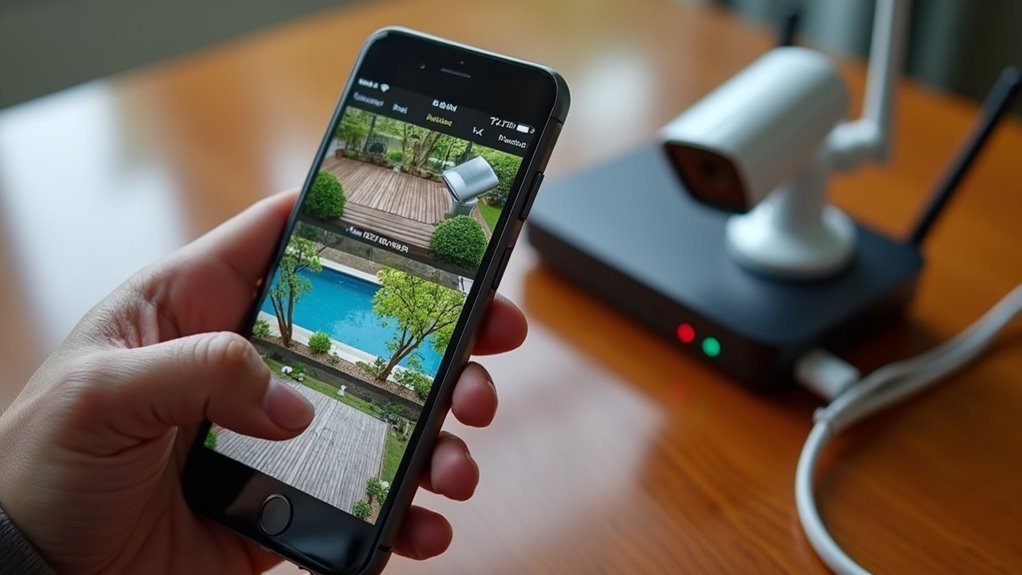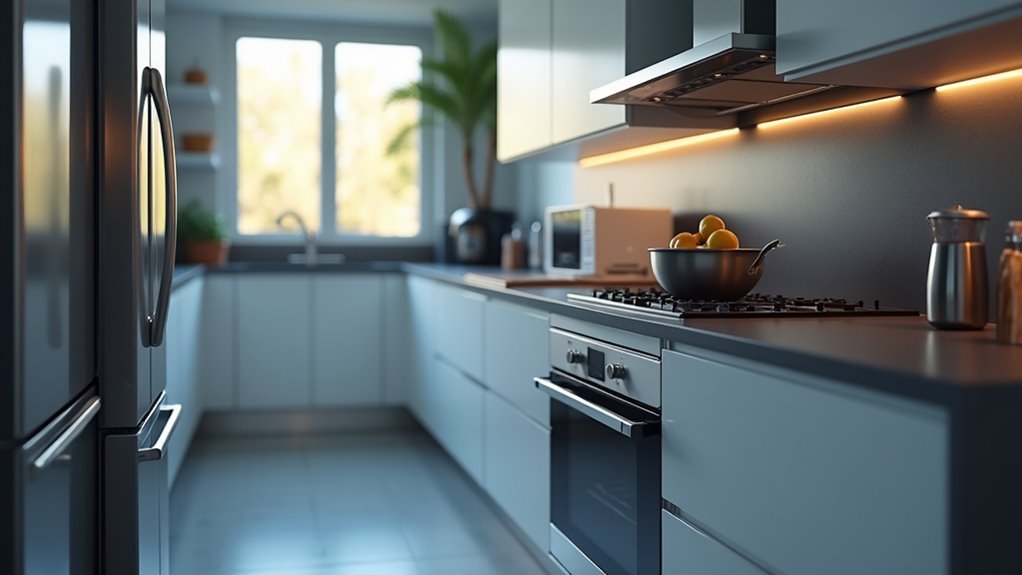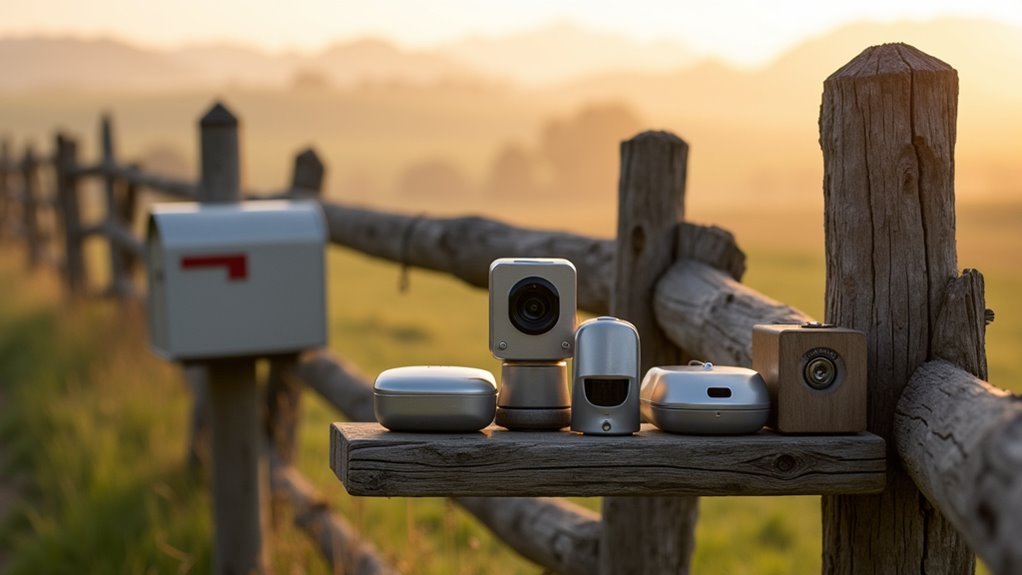Your old smartphone gathering dust in a drawer could become your home’s most versatile security guard and automation hub. You don’t need expensive sensors when your device already contains accelerometers, microphones, cameras, and connectivity that rival dedicated smart home equipment. By configuring the right apps and settings, you’ll transform that forgotten phone into a powerful monitoring system that detects everything from unexpected sounds to motion patterns—but the real magic happens when you discover what it can actually control.
Understanding Smartphone Presence Detection Technology

Seamless automation starts with your smartphone’s ability to detect whether you’re home or away. Your phone’s presence detection technology works by combining GPS, Wi-Fi, and Bluetooth signals to pinpoint your location within your home environment. This multi-layered approach guarantees your smart home system knows exactly when you arrive or leave.
Android devices typically outperform iOS phones as presence sensors because they maintain background activity more effectively. This continuous monitoring is vital for accurate detection and reliable automation triggers.
Android phones excel at presence detection through superior background monitoring capabilities, making them more reliable triggers for smart home automation systems.
However, your phone’s settings play a significant role in performance. You’ll need to enable background activity permissions for apps like SmartThings to function at peak efficiency.
When configured correctly, your smartphone becomes a powerful sensor that can automatically adjust lighting, open doors, and control other smart devices based on your location.
Essential Apps for Phone-Based Home Automation
While your smartphone’s built-in presence detection provides the foundation, dedicated apps release your device’s full potential as an all-encompassing home automation hub.
The SmartThings app stands out as the premier choice, enabling you to repurpose old Samsung phones as intelligent sensors through its Galaxy Upcycle feature. You’ll transform outdated devices into light and sound detectors by simply configuring their functions and locations within the app.
Your converted sensors recognize specific sounds like baby cries or breaking glass, sending real-time alerts directly to you.
The app’s detailed timeline view lets you track all sensor activities and adjust settings according to your preferences.
Remember to maintain your repurposed device’s battery at 35% to preserve its health while functioning as your smart home sensor.
Setting Up SmartThings for Device Integration

You’ll need to configure SmartThings properly to transform your old phone into a functional smart home sensor.
Start by opening the SmartThings app on your current device and navigate to the Menu icon to access the Labs section where you’ll find Galaxy Upcycle features.
Before proceeding, verify your old Galaxy phone meets the compatibility requirements and can connect to your home network for seamless integration.
Initial SmartThings App Configuration
Setting up SmartThings for device integration begins with opening the SmartThings app on your Samsung phone and maneuvering to the Menu at the bottom right of the screen.
Once you’ve accessed the menu, you’ll need to select “Labs” to reveal additional configuration options. From there, tap on “Galaxy Upcycle” to initiate the process of transforming your old phone into a smart home sensor.
The SmartThings configuration continues when you scan the QR code that appears using your phone’s default camera app. This action will direct you to download the Galaxy Upcycle app from the Galaxy Store.
After installing this companion app, open it and grant microphone permissions when prompted. You’ll then choose your preferred sensor type, such as light or sound detection capabilities.
Device Compatibility Requirements
Before connecting devices to your SmartThings network, check that each device displays either the “Works with Samsung SmartThings” or “Matter” compatibility badge.
These certifications guarantee your devices will integrate properly with your smart home ecosystem and support automation using SmartThings protocols.
Device compatibility requirements include using the same Samsung account across all connected devices.
This unified account approach enables seamless communication between your phone sensor and other smart home components.
You’ll need the SmartThings app, which works on both Android and iOS devices, though Android typically provides more reliable presence detection capabilities.
Remember to grant background activity permissions on all devices to maintain accurate automation using location-based triggers and guarantee your phone functions effectively as a smart home sensor throughout your daily routine.
Configuring Location Services and Permissions
Once you’ve installed the SmartThings app on your repurposed phone, configuring proper location services and permissions becomes essential for reliable smart home automation.
First, grant location permissions to the SmartThings app, as this enables accurate presence detection and automation triggers based on your location.
Next, enable background activity permissions so the app can continuously monitor your location even when it’s not actively open.
You’ll also want to regularly check and update both your phone’s operating system and the SmartThings app for peak performance and compatibility with location services.
If you notice presence detection becoming unreliable, try refreshing the SmartThings app or consider using alternative services like Life 360 to enhance your automation setups.
Creating Automated Triggers Based on Phone Location

With your location permissions properly configured, you can now create powerful automated triggers that respond to your phone’s position.
SmartThings lets you set up automations that activate when you arrive home or leave. You’ll find these options in the app’s automation section, where you can customize actions like turning on lights, adjusting thermostats, or opening doors based on your presence.
Set up location-based automations to automatically control lights, temperature, and doors when you arrive home or leave.
For best results, make certain background activity permissions stay enabled on your phone.
Android devices generally provide more reliable presence detection than iOS. If you’re experiencing inconsistent triggers, consider integrating Life 360 with SmartThings for enhanced accuracy.
This combination creates robust automation setups that reliably detect family members’ locations, making your smart home truly responsive to your daily routines.
Repurposing Old Android Devices as Dedicated Sensors
Rather than letting that old Android phone collect dust in a drawer, you can transform it into a dedicated smart home sensor using Samsung’s Galaxy Upcycle app. This innovative solution breathes new life into devices that might otherwise become electronic waste.
Setting up your repurposed sensor is straightforward. Simply scan a QR code with your old phone’s camera to download Galaxy Upcycle, then grant the necessary microphone permissions for peak functionality.
| Feature | Capability |
|---|---|
| Light Detection | Monitors ambient lighting changes |
| Sound Recognition | Identifies baby cries, glass breaking |
| SmartThings Integration | Real-time monitoring and control |
| Sensitivity Adjustment | Customizable trigger thresholds |
| Continuous Operation | Maintains functionality when plugged in |
Once configured, you’ll monitor everything through the SmartThings app, receiving notifications based on your customized sensitivity settings.
Building Custom Automation Rules and Routines
After transforming your old phone into a smart sensor, you’ll want to create automation rules that respond intelligently to the data it collects.
SmartThings enables you to build sophisticated routines that trigger based on your presence, time schedules, or sensor readings. You can set lights to turn on when you arrive home, or configure alerts when your phone’s sound sensor detects unusual noises.
Create intelligent home responses that adapt to your daily patterns, from arrival lighting to noise detection alerts, all powered by your repurposed device.
The platform’s strength lies in combining multiple conditions for complex scenarios. For instance, you can create rules that open your door only when you’re present and it’s between specific hours.
Through the SmartThings app, you’ll easily schedule bedtime routines that automatically turn off lights and lock doors. Monitor and adjust these automations in real-time based on your phone sensor’s data.
Integrating Multiple Sensors for Enhanced Detection
When you deploy multiple sensors throughout your home, you’ll create a thorough detection network that captures environmental changes from every angle.
The SmartThings app makes combining different sensor types seamless, boosting your automation system’s accuracy and responsiveness. You can transform an old Samsung phone into a multi-sensor powerhouse that detects sounds like breaking glass or crying babies alongside traditional motion and light sensors.
Managing this multi-sensor setup becomes effortless through SmartThings’ unified interface, where you’ll monitor real-time data and adjust settings for each device.
This integration enables smarter energy management and enhanced security by triggering actions based on combined sensor data. For example, lights automatically turn on when motion’s detected during nighttime hours, creating intelligent responses that adapt to your daily patterns.
Troubleshooting Common Connectivity Issues
When your phone struggles to maintain Bluetooth connections with smart home devices, you’ll often find the culprit lies in background activity restrictions or outdated app permissions.
Start by ensuring SmartThings has unrestricted background access, as this directly impacts sensor performance and device connectivity.
If connection drops persist, launch the SmartThings app manually to refresh your presence status and check that all location permissions remain enabled.
Bluetooth Connection Problems
Nothing disrupts your smart home experience quite like Bluetooth connectivity issues between your phone and sensors.
These problems can cripple your home automation system’s reliability and performance.
Start by ensuring Bluetooth is enabled on both devices, as this basic oversight causes most connection failures.
Check for physical obstructions or interference from other electronics that might disrupt the signal between your phone and sensor.
When connectivity persists, restart both devices to refresh the connection and clear temporary glitches.
Verify you’re within 30 feet of the sensor, as exceeding this range weakens the signal considerably.
Finally, update firmware on both your smartphone and sensor.
Outdated software creates compatibility issues that prevent proper Bluetooth communication, undermining your entire smart home setup.
App Permission Fixes
Incorrect app permissions silently sabotage your smart home sensor phone’s performance, blocking essential functions you’re counting on.
Start by enabling background activity permissions for your SmartThings app to maintain accurate presence detection and device connectivity. Without these permissions, your phone can’t communicate properly with your smart home ecosystem.
Next, grant location permissions to SmartThings since automation triggers depend on your presence data.
For sound sensor functionality through Galaxy Upcycle, verify microphone permissions are enabled. These settings directly impact your phone’s ability to detect environmental changes.
After adjusting permissions, restart your phone to guarantee changes take effect properly. This simple step resolves many connectivity problems.
Finally, keep your SmartThings app updated to the latest version for peak performance and bug fixes.
Optimizing Battery Life for Continuous Monitoring
Since your repurposed phone will monitor your home continuously, managing its battery life becomes essential for reliable operation. Keep your device plugged in and maintain charge above 35% to protect battery health during extended use.
Enable energy-saving features in the Galaxy Upcycle app by reducing screen brightness and limiting background data usage. These adjustments considerably extend battery life during sensor operation without compromising functionality.
Disable unnecessary applications and background services that drain power and interfere with monitoring reliability. Check your device’s running processes regularly to eliminate resource-heavy apps.
Adjust sensor sensitivity settings in the SmartThings app to prevent excessive battery drain from constant high-sensitivity monitoring.
Finally, activate your device’s built-in battery optimization settings to maximize performance while serving as your smart home sensor.
Privacy and Security Considerations
Beyond optimizing your device’s performance, protecting your personal information requires careful attention when transforming an old phone into a smart home sensor.
You’ll need to carefully manage permissions and privacy settings to maintain security while enjoying your sensor’s benefits.
- Review app permissions carefully – Only approve microphone and camera access for intended SmartThings functionality, and regularly audit these settings to prevent unauthorized data collection.
- Strengthen account security – Use a strong, unique password for your Samsung account since SmartThings requires this login to access your sensor data and control privacy settings.
- Secure deactivated devices properly – When you’re no longer using the phone sensor, make certain it’s completely wiped and deactivated to prevent potential privacy risks from lingering data.
Advanced Features and Customization Options
Two primary sensor types—light and sound—offer distinct customization possibilities when you’re setting up your repurposed phone through the Galaxy Upcycle app. You can configure your device as either sensor type or combine both for thorough monitoring capabilities.
Sound sensor customization lets you adjust sensitivity levels and fine-tune notification settings to recognize specific audio patterns. You’ll detect baby cries, glass breaking, or other security-relevant sounds with precision.
The SmartThings app enhances this functionality by providing detailed timeline views that track sensor activity in real-time.
Location designation within SmartThings allows organized monitoring across different rooms and areas. You’ll assign specific zones to each sensor, creating a structured home monitoring system.
Regular app updates guarantee your setup remains compatible with evolving SmartThings features and enhanced functionality.
Expanding Your DIY Smart Home Ecosystem
You can transform your single smart home sensor phone into an extensive network by connecting multiple repurposed devices through the SmartThings platform.
Adding more sensors from old smartphones creates detection points throughout your home, while third-party integrations like Life 360 enhance presence detection and automation triggers.
This multi-device approach lets you build custom sensor networks that respond to environmental changes across different rooms and locations.
Multi-Device Integration Strategies
As your DIY smart home grows beyond a single repurposed phone sensor, you’ll want to create a unified ecosystem where multiple devices work together seamlessly. SmartThings serves as an excellent central platform for managing various appliances and sensors from one interface.
To maximize your integration success:
- Choose compatible devices – Look for SmartThings or Matter badges when purchasing new smart devices to guarantee they’ll communicate effectively with your existing components.
- Leverage presence detection – Use services like Life 360 for more reliable automation triggers compared to traditional mobile device integrations.
- Create combination routines – Set up automations that respond to multiple sensor inputs, like adjusting temperature and lighting based on family presence detection.
Remember to regularly update your SmartThings app and connected devices to access new features and maintain ideal compatibility.
Sensor Network Expansion
When one repurposed smartphone sensor proves its worth in your smart home setup, you’ll naturally want to expand that network with additional monitoring points throughout your house.
SmartThings makes scaling your DIY ecosystem straightforward by supporting multiple device types simultaneously.
You can strategically place old phones as light and sound sensors in different rooms, creating extensive environmental monitoring without buying expensive dedicated hardware.
Combine these smartphone sensors with motion detectors and other smart devices to build a robust network that responds to real-time data changes.
This multi-sensor approach enables sophisticated automation routines that improve both security and energy efficiency.
Adding third-party services like Life360 further enhances your network by providing reliable presence detection, allowing your system to automatically adjust based on family members’ locations and daily patterns.
Frequently Asked Questions
How to Control Your House With Your Phone?
Download SmartThings app to remotely control home appliances. Set up automated routines that activate devices when you’re present. Enable location permissions for accurate presence detection. You can also integrate Life 360 for enhanced family tracking.
How Do I Use My Android Phone as a Smart Display?
Download the Google Home app on your Android phone. Connect to the same Wi-Fi network as your smart devices. Use Cast to mirror your display onto a TV, creating a larger smart interface.
Can You Turn Your Phone Into a Remote?
Yes, you can turn your Samsung phone into a remote control using the SmartThings app. It’ll control compatible smart home devices, create automation routines, and monitor settings from one centralized interface.
Does Samsung Have a Smart Home Hub?
Yes, Samsung offers the SmartThings Hub as their central smart home control point. You’ll connect various compatible devices through it and manage everything remotely using Samsung’s SmartThings app on your smartphone.





Leave a Reply